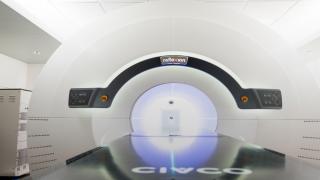City of Hope is the first health system in Southern California to offer patients diagnosed with primary or metastatic lung and bone cancer a new form of radiotherapy that can detect and treat multiple tumors in real time using precision targeting.

The RefleXion® X1 system delivers SCINTIX™ biology-guided radiotherapy, a leading-edge treatment that combines positron emission tomography (PET) with targeted radiation therapy. By using fluorodeoxyglucose (FDG), a radiotracer that causes solid tumors to light up on a PET, cancer cells are tracked in real time, even in tumors that are moving.
As part of their treatment regimen, between half and two-thirds of cancer patients receive radiotherapy, according to the American Society for Therapeutic Radiology and Oncology. Radiotherapy is increasingly used in combination with chemotherapy or immunotherapy to treat the disease. However, one of the longest-standing challenges in radiotherapy is managing tumor motion, which is difficult to do when even the smallest movement can make cancer cells’ location difficult to pinpoint.
With SCINTIX therapy, PET emissions from the tumor are used to help guide the radiation to the precise location of the tumor target. Locations must also be precise because identifying a wrong location can cause radiation to damage healthy cells. This technology minimizes the risk of missing the tumor due to tumor motion.

“City of Hope is committed to finding more effective treatments with fewer side effects for our patients, and being one of the first cancer systems in the nation to offer this groundbreaking technology aligns strongly with our mission,” said Terence Williams, M.D., Ph.D., professor and chair of the Department of Radiation Oncology at City of Hope. “Lung and bone cancer patients with metastatic disease now have an option with the potential to target more tumors with fewer side effects by minimizing damage to healthy cells, both critical factors in patients with advanced disease.”
“We hope this opens the door to more patients with metastatic cancers to have precision medicine radiotherapy treatment options that leverage the biology of the tumor,” he added.
Earlier this year, RefleXion received clearance for the use of SCINTIX from the U.S. Food and Drug Administration (FDA) to treat primary or metastatic lung and bone cancer tumors. For initial use of this technology at City of Hope, eligible patients will have one to two lung or bone tumors that are each 1 to 5 cm in size.
City of Hope was one of the first to use RefleXion’s technology in clinical research studies and continues to be an early adopter of leading-edge radiation technology that later becomes standard-of-care.
In addition, City of Hope is developing and testing new and more sensitive PET imaging tracers that identify disease targets by “lighting them up,” including additional PET tracers to detect cancers of the prostate gland, gastrointestinal tract, breast, lung, blood and bone marrow. City of Hope is also developing novel radioactive antibodies to treat cancers and developing molecular signatures that predict response to radiation or the need for radiation. Through their efforts, City of Hope researchers hope to bring the world closer to the ability to deliver personalized radiotherapy treatment that is specific to a particular cancer.
City of Hope is a minority investor in RefleXion, and currently holds less than 1% of the company’s outstanding shares.
